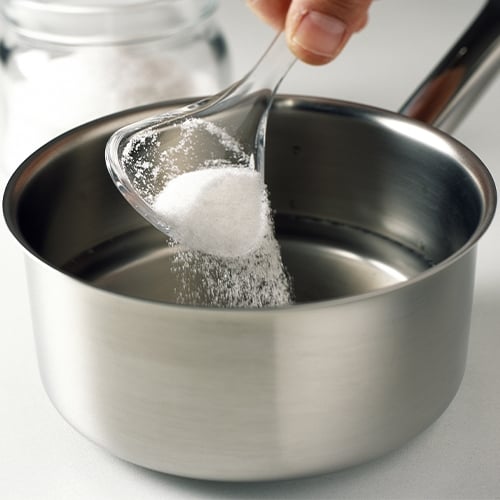What Is Invert Sugar?
Last updated on Jun 3, 2025Val GoodrichInvert sugar is a liquid sweetener made by breaking down sucrose into its two simpler components, glucose and fructose. This versatile ingredient enhances texture, extends shelf life, and improves sweetness distribution in baked goods, beverages, and desserts. Unlike other types of sweeteners such as regular sugar or simple syrup, invert sugar offers superior performance in recipes requiring consistent quality and moisture retention. Whether you're crafting artisanal ice creams or glossy glazes, understanding invert sugar can elevate your menu offerings.
What Is Invert Sugar?

Invert sugar is table sugar (also known as sucrose) broken into the molecular bonds of glucose and fructose. The result is a thick-as-honey, clear liquid that boasts all the benefits of conventional sweeteners with additional features. Also known as inverted sugar, invert sugar syrup, and trimoline, this concoction is the preferred form of sugar by many bakers, confectioners, and sauce makers.
Invert Sugar vs Sugar
The difference between sugar and invert sugar is their monosaccharide bonding. Granulated sugar is also known as sucrose, a disaccharide composed of two monosaccharides bonded together: glucose and fructose. Because the monosaccharides in granulated sugar are bonded, granulated sugar is in a solid state.
Inverted sugar is also sucrose. However, the glucose and fructose in inverted sugar are split in the cooking process with citric acid and water, resulting in a liquid state.
Invert Sugar vs High Fructose Corn Syrup
The difference between high fructose corn syrup and invert sugar is their glucose-to-fructose ratio. While invert sugar has a 1:1 ratio, high fructose corn syrup goes through enzymatic processing, resulting in higher fructose percentages and lower glucose percentages. Otherwise, the end products’ viscosity (a fluid's thickness) and taste are similar.
Invert Sugar vs Simple Syrup
Simple syrup is a 1:1 ratio of sugar and water, where the sugar has been fully dissolved into the water, creating a low viscosity and subtly sweet syrup. Inverted sugar is a 2:1 ratio of sugar and water, along with the addition of citric acid. It’s cooked in a temperature-controlled environment to manipulate the sugar molecules to split, resulting in higher viscosity and substantially sweeter syrup than simple syrup.
Invert Sugar Benefits
Invert sugar gives foodservice operations a competitive edge by enhancing quality and efficiency. Its intense sweetness means you need less product to achieve the desired flavor profile, helping control food costs without sacrificing taste. The syrup's exceptional moisture retention is ideal for shipping baked goods, as it prevents staling and maintains freshness during transport, a game-changer for bakeries and dessert suppliers.
The sweetener truly shines in professional applications, particularly when crafting premium frozen desserts that demand smooth textures or preparing various types of frosting that need to hold their structure. By resisting crystallization, invert sugar contributes to consistent results batch after batch, whether you're producing glossy icings, pliable fondants, or creamy gelatos. For kitchens focused on delivering superior, shelf-stable sweet creations, incorporating invert sugar can transform both product quality and operational performance.
Invert Sugar Uses

Invert sugar can be used for desserts, candies, and beverages as a substitute for standard sugar, high fructose sugar, and simple syrup.
Invert Sugar in Desserts
Invert sugar makes desserts softer and chewier by retaining moisture easier than other sugars. This quality also keeps the desserts from drying out and lengthens their shelf life. Consider using invert sugar in the following desserts:
- Cookies
- Brownies
- Ice cream
- Sorbet
- Sweet breads
- Icing
- Fondant
- Ganache
Invert Sugar in Candies
Invert sugar is used as the sweetener in candies because it can slow down and often fully resist crystallization. Invert sugar also maintains a long shelf life for candies and truffle fillings. Confectioners should consider using invert sugar in the following items, especially if they plan to package their chocolate for shipment:
- Fudge
- Toffee
- Marshmallows
- Caramels
- Taffy
Invert Sugar in Beverages

Beverages benefit from the use of invert sugar because it fully dissolves in both hot and cold drinks. Invert sugar is also noticeably sweeter than other sweeteners, making it a more economical option because less sugar is needed to achieve the desired taste. From coffee drinks and cocktails to beer and wine, invert sugar is an excellent choice for the following beverages:
Back to TopHow To Make Invert Sugar
Invert sugar is simple to make, requiring only a few affordable ingredients and basic skills. It also stays fresh for months, but since it's such a versatile ingredient, you probably won't have to worry about using all of it before it goes bad.

Invert Sugar Ingredients
Check that you have all these kitchen tools and invert sugar ingredients before you start the recipe.
Tools
- Heavy-bottomed pot
- Rubber spatula
- Pastry brush
- Small bowl of water
- Candy thermometer
- Glass jar with a secure-fitting lid
Ingredients
- 4 cups table sugar
- 2 cups water
- 1/4 tsp. citric acid
Directions
- Add table sugar, water, and citric acid into clean pot. Stir until it comes together.
- Heat mixture over medium heat until it comes to a gentle boil. Do not stir for the rest of the recipe or the sugars will crystalize, resulting in hard, gritty sugar.
- Reduce heat to low and let simmer for 20 minutes.
- While simmering, brush away any sugar crystals that formed on the edges of pot with pastry brush dipped in water.
- Your sugar is finished cooking when it reaches the soft ball stage: 234-236 degrees Fahrenheit or 112-114 degrees Celsius.
- Remove pot from heat.
- Let sugar cool to room temperature, then pour sugar into glass jar. It should thicken to corn syrup or honey consistency when cooled.
Invert Sugar Syrup FAQs
Have more questions about invert sugar? We provided answers to the most frequently asked questions chefs have when they cook with inverted sugar below:
Invert Sugar Substitute

Honey and agave nectar work well as 1:1 replacements, offering similar moisture retention and sweetness levels, though they may impart subtle flavor variations. For applications requiring invert sugar's anti-crystallization properties, light corn syrup or golden syrup can maintain smooth textures in frostings and frozen desserts. Glucose syrup serves as another viable option, particularly in candy-making and ice cream production where crystallization prevention is critical. However, in high-volume operations where shelf stability and texture are paramount, invert sugar often remains the superior choice for reliable, repeatable outcomes.
Is Honey an Invert Sugar?
While honey shares similarities with invert sugar, containing naturally occurring glucose and fructose, it isn't technically the same. Commercial invert sugar is manufactured by precisely breaking down sucrose, while honey's composition varies based on floral source and processing. For foodservice use, honey can mimic some functional properties of invert sugar but may introduce distinct flavors and require recipe adjustments due to its higher acidity and moisture content. Honey works well as a substitute in applications like glazes or moist baked goods, but it isn't ideal for recipes requiring neutral sweetness or strict consistency.
Is Invert Sugar Bad for You?
Invert sugar has a similar nutritional value to other added sugars. Researchers link added sugars to negative health outcomes. So, while invert sugar is not worse for you than a different added sugar, it also isn’t any better. To follow a healthy diet, only use inverted sugar and other added sugars moderately. Sugar that is inverted enzymatically rather than through chemicals or acids does not produce any polymerized byproducts and is a healthier alternative to conventional acid-hydrolyzed invert.
Is Invert Sugar Vegan?
As a form of refined sugar, each manufacturer's processing and filtration methods determine if their invert sugar is vegan. To guarantee that an invert sugar is vegan, contact its manufacturer.
What Is Medium Invert Sugar?
Since splitting sucrose into glucose and fructose produces invert sugar, some manufacturers make a partially inverted sugar known as medium invert sugar. Medium invert sugar is when some of the original sugar is unchanged. It contains 50 percent table sugar and 50 percent invert.
If you’re replacing regular sugar with medium invert syrup, you only need to use 20 percent of the called-for amount. Since you can use less of it to achieve the same sweetness level, medium invert sugar is a healthier and more economical choice than regular sugar.
What Is the Use of Citric Acid in Invert Sugar?
Citric acid keeps inverted sugar in its liquid form. It stimulates the reaction that splits the sucrose bonds into glucose and fructose. Need a substitute for citric acid? You can use fresh lemon juice or cream of tartar instead.
Back to TopMastering the use of invert sugar can be a game-changer for your menu, offering unmatched consistency, improved texture, and extended freshness in everything from pastries to cocktails. By understanding its advantages over traditional sweeteners you gain a competitive edge in delivering high-quality, chef-driven creations. Whether you're refining recipes or exploring new applications, invert sugar provides a reliable solution for elevating taste and presentation.



